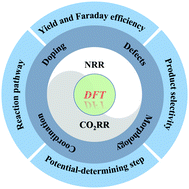Significance of density functional theory (DFT) calculations for electrocatalysis of N2 and CO2 reduction reactions
Abstract
Density functional theory (DFT) based computational methods have shown great significance in developing high-performance electrocatalysts. In this perspective, we briefly summarized the state-of-the-art research progress of electrocatalysts for the nitrogen reduction reaction (NRR) and CO2 reduction reaction (CO2RR), which are important processes for the conversion of common molecules into value-added products. With the help of DFT calculations, various modulation strategies are employed to improve the catalytic activity and performance of NRR and CO2RR electrocatalysts. DFT calculations are performed to confirm the surface catalytic sites, evaluate the catalytic activity, reveal the possible reaction mechanisms, and design novel structures with high catalytic performance. By discussing the currently applied computational methods and conditions during the calculations, we outlined our concerns on the prospects and future challenges of DFT calculations in electrocatalysis studies.

- This article is part of the themed collection: PCCP Perspectives


 Please wait while we load your content...
Please wait while we load your content...